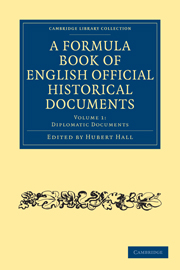Book contents
- Frontmatter
- PREFACE
- Contents
- ABBREVIATIONS USED IN THE REFERENCES, ETC. OF THIS WORK
- I INSTRUMENTS UNDER THE GREAT SEAL
- II INSTRUMENTS UNDER THE SMALLER SEALS
- 1 WRITS AND LETTERS MISSIVE
- 2 WARRANTS FOR THE ISSUE OF THE GREAT SEAL
- 3 DEPARTMENTAL WARRANTS FOR THE ISSUE OF THE GREAT SEAL
- III DEPARTMENTAL INSTRUMENTS
- IV SEMI-OFFICIAL INSTRUMENTS
- V STATE PAPERS AND DEPARTMENTAL INSTRUMENTS
2 - WARRANTS FOR THE ISSUE OF THE GREAT SEAL
Published online by Cambridge University Press: 05 October 2010
- Frontmatter
- PREFACE
- Contents
- ABBREVIATIONS USED IN THE REFERENCES, ETC. OF THIS WORK
- I INSTRUMENTS UNDER THE GREAT SEAL
- II INSTRUMENTS UNDER THE SMALLER SEALS
- 1 WRITS AND LETTERS MISSIVE
- 2 WARRANTS FOR THE ISSUE OF THE GREAT SEAL
- 3 DEPARTMENTAL WARRANTS FOR THE ISSUE OF THE GREAT SEAL
- III DEPARTMENTAL INSTRUMENTS
- IV SEMI-OFFICIAL INSTRUMENTS
- V STATE PAPERS AND DEPARTMENTAL INSTRUMENTS
Summary
(a) Early Procedure
The normal use of Writs or Letters of Privy Seal, Signet Letters and Sign Manual Warrants in the mediaeval period would seem to have been connected with the issue of Letters Patent, rather than with the administrative matters which were dealt with by the Missive instruments described above. On the other hand, it is probable that the rescripts or possibly the enrolments of the latter species no longer exist, though as we have seen a certain number of missive forms occur in the Files of original Warrants for Issue.
An attempt has been made here to show the sequence of these instruments under certain conditions, distinguishing between the earlier and the later procedure as determined by the Statute of 1535.
Although the normal procedure, as indicated by the sequence of instruments printed below (Nos. 107—109 and 122), would seem to indicate that in both periods the first step in the direction of obtaining the grant of Letters Patent was taken by way of a Petition addressed to the Crown, the intervention of a Petition in all cases cannot be assumed. It will be inferred from the documents printed below that private instructions might be given for this purpose either verbally (No. 105) or by a private letter (No. 106).
Again it was sometimes enough that a petitioner should ‘speak with’ the Chancellor, Chamberlains or other courtiers; but in the. interests of a new and increasing branch of royal revenue, it was considered desirable to treat a written petition as the basis of the departmental procedure for issuing the several seals.
- Type
- Chapter
- Information
- A Formula Book of English Official Historical Documents , pp. 100 - 118Publisher: Cambridge University PressPrint publication year: 2010First published in: 1908



